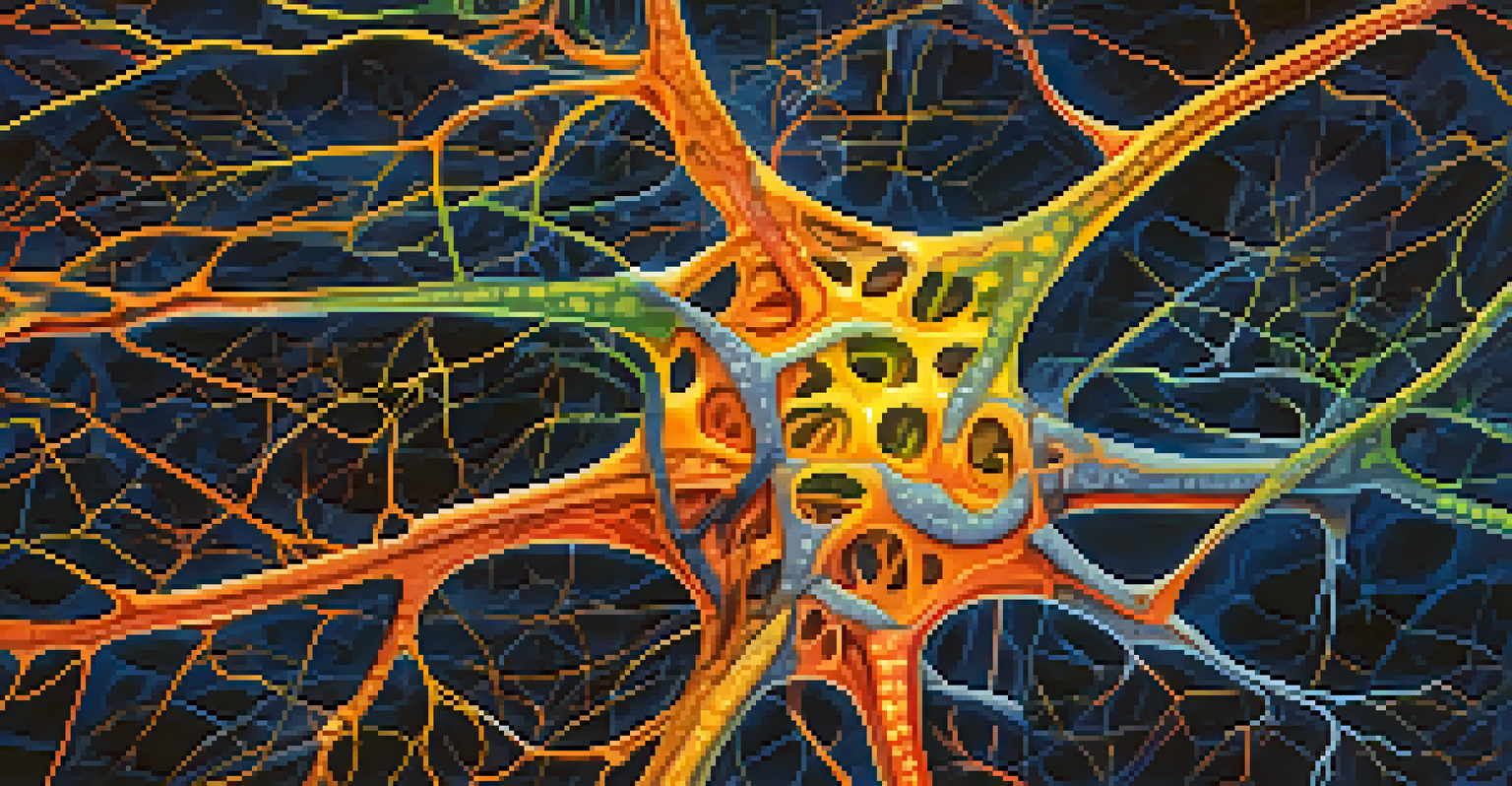Entheogens and the Brain's Reward Pathways: A Study

Understanding Entheogens: Nature's Psychedelic Compounds
Entheogens are naturally occurring substances that induce altered states of consciousness, often used in spiritual or therapeutic contexts. Common examples include psilocybin mushrooms, peyote, and ayahuasca. These compounds have been revered for centuries in various cultures for their transformative and healing properties, inviting users to explore deeper aspects of their psyche.
Psychedelics are a catalyst for change, allowing us to see the world anew and understand ourselves better.
While these substances are often associated with mystical experiences, their effects on the brain are equally fascinating. Research has shown that entheogens can modulate brain activity, particularly in areas related to emotion and cognition. This opens up a dialogue about their potential therapeutic applications, especially in treating mental health conditions such as depression and PTSD.
As we delve into this topic, it’s essential to understand how entheogens interact with the brain's reward pathways, which play a crucial role in how we experience pleasure and motivation. By examining these interactions, we can gain insights into both the risks and benefits of these powerful substances.
The Brain's Reward Pathways: An Overview
The brain's reward pathways are intricate networks that signal pleasure, helping us to learn and repeat behaviors associated with positive outcomes. Primarily driven by dopamine, these pathways influence our motivation and reinforce behaviors that promote survival, like eating and socializing. Understanding how these pathways function is key to deciphering the complex effects of entheogens.

When we engage in activities that we find enjoyable, our brain releases dopamine, creating a sense of pleasure and satisfaction. This reward mechanism can also be triggered by various substances, including drugs and, interestingly, entheogens. By understanding these processes, researchers can explore how entheogens might either enhance or disrupt our natural reward systems.
Entheogens and Mental Health
Entheogens show promise in treating mental health conditions like depression and anxiety through their unique interactions with the brain.
Moreover, the brain's reward pathways are not just about immediate pleasure; they also involve learning and memory. This is particularly relevant when considering how entheogens might facilitate new insights or behavioral changes through their unique effects on these pathways, potentially leading to lasting transformations in users.
How Entheogens Affect Neurotransmitter Activity
Entheogens primarily affect neurotransmitters, the chemical messengers in our brain, which play a significant role in our emotional and cognitive states. For instance, substances like psilocybin interact with serotonin receptors, leading to altered perceptions and emotions. This interaction can create a sense of interconnectedness and profound experiences, which many users describe as life-changing.
The mind is not a vessel to be filled but a fire to be kindled.
The modulation of neurotransmitter activity suggests that entheogens can not only influence mood but also reshape our cognitive frameworks. This means that they might help individuals break free from negative thought patterns or entrenched beliefs. The potential for these substances to aid in psychotherapy is a growing area of research, with promising results in clinical trials.
However, it’s crucial to approach this topic with caution. While the benefits of entheogens are compelling, they also come with risks, particularly when used outside of controlled environments. Understanding the balance between their therapeutic potential and the dangers of misuse is essential for anyone considering their use.
Entheogens and Emotional Regulation
One of the most intriguing aspects of entheogens is their potential to enhance emotional regulation. Users often report a heightened awareness of their emotional states during and after experiences with these substances. This can lead to greater empathy, improved relationships, and a deeper understanding of oneself and others.
Research indicates that entheogens may help reset dysfunctional emotional patterns, providing users with a fresh perspective on their problems. For example, individuals grappling with anxiety or depression might find that their experiences with these substances allow them to confront and process emotions that they typically avoid. This newfound emotional clarity can be incredibly liberating.
Risks of Using Entheogens
While entheogens can offer therapeutic benefits, they also carry risks, especially for individuals with a history of mental health issues.
By fostering emotional resilience, entheogens can potentially serve as powerful tools in therapy. However, it's essential to approach this with professional guidance and support, ensuring that individuals can safely navigate their emotional journeys while minimizing risks.
Potential Therapeutic Applications of Entheogens
The therapeutic potential of entheogens has garnered significant interest from researchers and mental health professionals alike. Early studies suggest that these substances may be effective in treating various mental health conditions, including depression, anxiety, and substance abuse disorders. This has led to a resurgence of interest in psychedelic research, often referred to as the 'psychedelic renaissance.'
For instance, clinical trials involving psilocybin have shown promising results in alleviating symptoms of treatment-resistant depression. Participants often report experiencing profound insights and emotional breakthroughs during their sessions, which can lead to lasting changes in their mental health. These findings highlight the importance of understanding how entheogens interact with the brain’s reward pathways to create these effects.
Despite the growing body of evidence, it’s vital to approach these applications with caution. More research is needed to understand the long-term effects, optimal dosages, and the best therapeutic settings for these substances. The goal is to ensure that entheogens are used safely and effectively, maximizing their benefits while minimizing potential harm.
Risks and Considerations of Using Entheogens
While entheogens hold promise for therapeutic applications, they are not without risks. Users may experience adverse psychological effects, such as anxiety, paranoia, or even psychosis, especially if they have a history of mental health issues. It’s crucial to acknowledge these potential dangers to make informed decisions about their use.
Moreover, the context in which entheogens are consumed plays a significant role in the overall experience. Set and setting—referring to a person's mindset and the physical environment—can greatly influence how one reacts to these substances. Therefore, creating a safe and supportive environment is essential for minimizing risks and enhancing positive outcomes.
Future of Psychedelic Research
Ongoing research aims to integrate entheogens into mental health treatment, challenging existing stigmas and promoting a better understanding of their potential.
Education and preparation are key components for anyone considering the use of entheogens. By understanding both the potential benefits and the associated risks, individuals can make more informed choices, engage in safer practices, and ideally, achieve the desired therapeutic effects.
The Future of Entheogens in Mental Health Treatment
As research into entheogens continues to expand, the future of these substances in mental health treatment looks promising. More clinical studies are underway, aiming to unlock the full potential of these compounds for various mental health issues. This could lead to a paradigm shift in how we approach mental health care, integrating entheogens into therapeutic practices alongside traditional treatments.
However, the journey toward acceptance and integration is not without challenges. Stigma surrounding the use of psychedelics persists, often hindering research and clinical applications. Advocacy and education are essential to change perceptions and promote a more nuanced understanding of these substances and their potential benefits.

Ultimately, the future of entheogens in mental health treatment will depend on continued research, responsible use, and open conversations. By fostering a supportive and informed environment, we can hope to bridge the gap between traditional therapies and the transformative potential of entheogens.